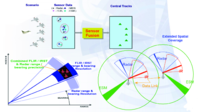
Photo from wikipedia
In clinical practice, multi-modal magnetic resonance imaging (MRI) with different contrasts is usually acquired in a single study to assess different properties of the same region of interest in the… Click to show full abstract
In clinical practice, multi-modal magnetic resonance imaging (MRI) with different contrasts is usually acquired in a single study to assess different properties of the same region of interest in the human body. The whole acquisition process can be accelerated by having one or more modalities under-sampled in the k-space. Recent research has shown that, considering the redundancy between different modalities, a target MRI modality under-sampled in the k-space can be more efficiently reconstructed with a fully-sampled reference MRI modality. However, we find that the performance of the aforementioned multi-modal reconstruction can be negatively affected by subtle spatial misalignment between different modalities, which is actually common in clinical practice. In this paper, we improve the quality of multi-modal reconstruction by compensating for such spatial misalignment with a spatial alignment network. First, our spatial alignment network estimates the displacement between the fully-sampled reference and the under-sampled target images, and warps the reference image accordingly. Then, the aligned fully-sampled reference image joins the multi-modal reconstruction of the under-sampled target image. Also, considering the contrast difference between the target and reference images, we have designed a cross-modality-synthesis-based registration loss in combination with the reconstruction loss, to jointly train the spatial alignment network and the reconstruction network. The experiments on both clinical MRI and multi-coil k-space raw data demonstrate the superiority and robustness of the multi-modal MRI reconstruction empowered with our spatial alignment network. Our code is publicly available at https://github.com/woxuankai/SpatialAlignmentNetwork.
Journal Title: IEEE transactions on medical imaging
Year Published: 2022
Link to full text (if available)
Share on Social Media: Sign Up to like & get
recommendations!